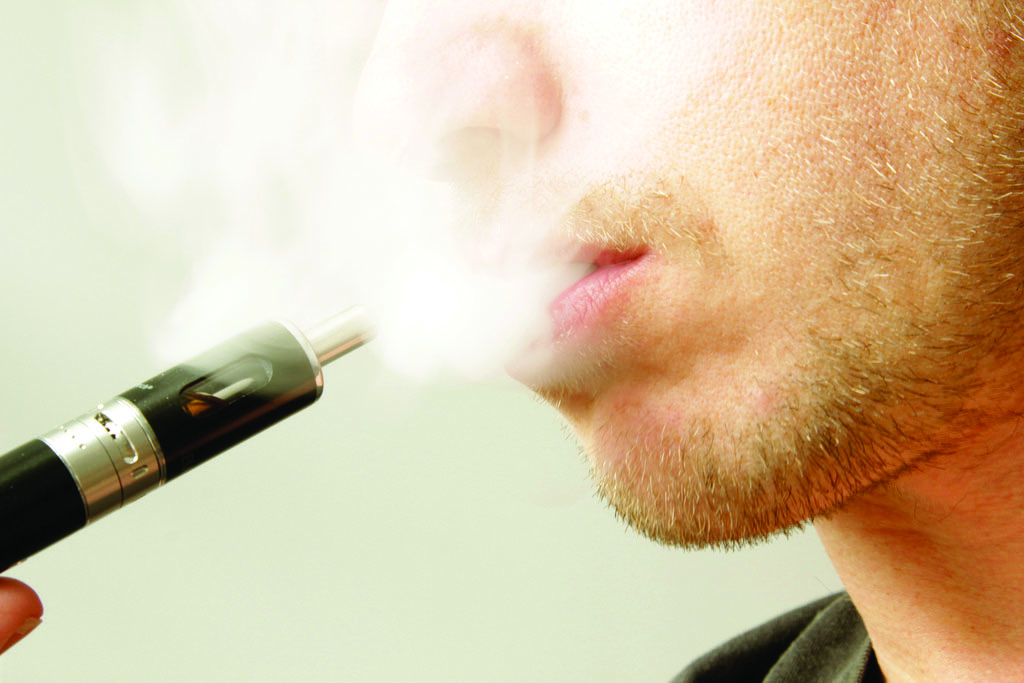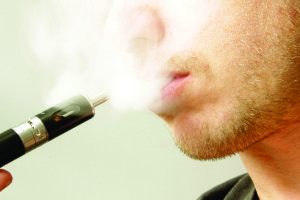
By Michael Diambri, A&E writer
When we were kids, we were taught that smoking kills. This generation was thought of as the one that could finally kick the nicotine craze. This may not be so, because “vaping,” smoking using an electronic cigarette, has become a popular habit among young adults.
Most electronic cigarette manufacturers also produce e-cig liquid, which contains little or no tobacco. This has led many of the members of the e-cig industry to promote vaping as a safer, healthier option than other means of smoking.
This claim may not be accurate. These juices often contain nicotine, the main cause of most smoking addictions.
The research into the effects of vaping is far behind the incredibly fast – growing rate of the electronic cigarette industry.
With this new revolutionary form of smoking comes new laws and regulations.
Legally, people can “vape” as much as they want anywhere it’s allowed, as long as the cigarette is battery powered and doesn’t contain tobacco.
This has led to situations where vaping has been spotted at movie theaters, concerts and even schools.
Buying an electronic cigarette and vaping is technically illegal for anyone younger than 18. The laws surrounding e-cig purchases are generally similar to those that surround smoking and using tobacco products in Washington state. These laws are hard to regulate and enforce with e-cigs because of their online availability.
Vaping has become more appealing than smoking. Individuals can still achieve a nicotine buzz while not having to withstand the taste or smell of traditional cigarettes.
In fact, people can vape while enjoying a wide variety of flavors, including bubble gum, raspberry, mint, watermelon and coffee. Many health officials and parent groups are concerned that the flavors and nicotine may make it a gateway to smoking, especially for teenagers.
It is common knowledge that nicotine is an addictive substance. Nicotine addiction could be promoted by using an electronic cigarette.
Another concern about electronic cigarettes is that certain types of vaporizers can be used for THC-based products, such as dabs or hash oil, which are considered illegal in many on college campuses, states and in any other area that receives federal funding or is owned by the government.
Vaping has become more popular and acceptable in our culture, especially with younger people. This is because the e-cig industry does a lot of its marketing through social media.
In addition, anyone can find a plethora of videos online about how to perform creative smoke tricks while vaping, often making it seem cooler to younger children and adults.
There are also influences from celebrity icons and peer groups. Vapes can be spotted at almost any college party or one can simply drive around Parkland, where a wide variety of people can be seen vaping in their cars. Many celebrities like Katy Perry and Leonardo DiCaprio have been known to enjoy vaping as well.
With all this stated, what is Pacific Lutheran University’s stance on the use of tobacco-free electronic cigarettes?
As I interviewed PLU staff I got the same answer: PLU is a tobacco-free campus. But electronic cigarettes usually contain no tobacco.
I spoke with Terri Phillips, the Associate Vice President of Human Resources about PLU’s policies, on electronic cigarettes and its tobacco-free policy.
Phillips confirmed the use of e-cigs on campus is not allowed.
“We made an informed decision to be tobacco free, within this policy we decided to include electronic cigarettes,” Phillips said. “E-cigs are not FDA approved and the Pierce County Health Department has banned them in public places as well. This alarmed us as a safety concern and we are very concerned about the health and wellness of the PLU community.”
I sat down with a first-year student, who chose to remain anonymous. He confessed he set off a smoke detector while vaping in his room on campus. “I was just sitting in my room with friends, we had been vaping for around 30 minutes and the smoke detector went off” he said.
“I knew that it was a tobacco free campus, the vape had no tobacco and my vape had no nicotine in it,” he said. “I didn’t think it would be against any rules.”
He said he knew a lot of people who had done this.
“That was the original purpose for their use” he said. “The whole community of e-cigs and vaping is about getting people off of cigarettes.”
When asked if e-cigs were healthy this student did say that e-cigs indeed were unhealthy.
“Bottom line, it is not healthy to put anything in your lungs that isn’t air” he said. “It’s become a very social thing.”
When asked about what PLU should do about e-cigs he said, “I don’t want the school to make a big deal out this, it does really help people get off nicotine. I do think people should avoid vaping in their rooms because it can set off alarms” he said. “Campus Safety told me that the smoke detectors are very sensitive here.”
Evidence shows vaping can actually set off fire alarms, but there have also been reports of other products such as air freshener, hairspray and burnt toast setting off alarms as well. These are examples of products PLU can restrict from being in the residence halls, but are unable to enforce.
E-cigs are different because the university does not want students to engage in an unhealthy lifestyle.
Tom Huelsbeck, the associate dean for Campus Life and Executive Director of Residential Life, released a statement to me providing information on PLU’s residential life policies on electronic cigarettes.
“The use of e-cigarettes is not permitted on campus as a part of the University Policy: Tobacco Free Campus,” Huelsbeck said. The residence halls are included in this policy because they are a part of campus, but it is not a Residential Life policy. The primary issue is the health related concerns associated with e-cigarettes (even though they don’t contain tobacco).”
PLU and other universities need to make their policies on the use of electronic cigarettes known to their students. Saying a campus is “tobacco-free” is not specific enough.
The American Heart Association reported e-cigarettes differ from traditional cigarettes in that they do not contain carcinogens such as arsenic and vinyl chloride. Additionally, there isn’t secondhand smoke associated with vaping. The main components of a cartridge of “juice” are nicotine, propylene glycol, solvents and flavors.
According to USA Today, “Due to the relative newness in the popularity of vaping, the long-term effects of vaping have yet to be analyzed.”
Tobacco control expert at the Boston University School of Public Health Michael Siegel said “as long as e-cigs are primarily used to help quite smoking and not to spur kids to smoke, they will be a benefit to public health.”
Many people addicted to cigarettes said vaping helped them quit smoking and other tobacco products. Most of them said they did this by switching to e-cigs and then slowly reducing the nicotine-level.
Although many people may claim this to be true, the Washington State Department of Health does not encourage this as a method of quitting smoking. However, quitting smoking is clearly no longer the primary use of e-cigs.
I recommend that young people avoid using them. Because there is not a lot of agreement on the use of e-cigs, people should not partake in vaping just because it is considered something that is fun to do.
I encountered a number of people who could attest e-cigs can help people quit smoking, but the process took a long time. Only one person I talked to had fully quit smoking, meaning they no longer even used an e-cig.
The risks are much higher than the rewards, in this case, so don’t smoke.
If you want more of the DOH’s opinion and research on e-cigs go to: http://www.doh.wa.gov/YouandYourFamily/Tobacco/OtherTobaccoProducts/ECigarettes

This image is released under Creative Commons. If used, please attribute to www.ecigclick.co.uk.
















